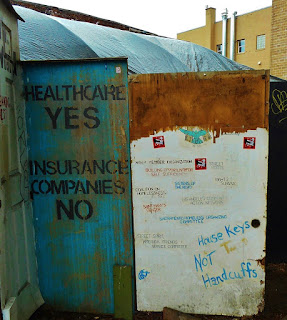By Sarah Rohrs
The Right to Rest…The Right to Sleep…The Right to Dream…
Today’s housing market is unkind to the very poor. When they can no longer pay their rent they often find themselves on the streets. When evicted, the very poor have few places to go, few places to get clean, use the bathroom, and few places to get a good night’s sleep.
The Right to Dream Too (R2DToo) shelter in downtown Portland affirms sleep as a basic human right. This compact outdoor shelter is in the heart of Portland’s Old Town and on the edge of its Chinatown. It has tarps serving as a roof and wooden doors edging the sidewalk much like a fence. Inside are tents, cots, and other places to safely bed down for the day or night. Numerous portable bathrooms and washing facilities also on hand.
I ran across Right to Dream Too encampment while on a short sight-seeing trip to Portland. After hearing repeatedly of Portland’s ever-escalating housing costs, it was by no means a surprise to see so many homeless people nearly everywhere I went in the downtown. They sit for hours on park benches, and dozens are sprawled out the length of a long city block in front of the Greyhound bus station. In fact, Portland’s growing bands of homeless were the first people I saw leaving the bus station before I and my traveling companion began to walk around.
I stood on the corner of Fourth Avenue NW and Burnside Street, looking at the busy homeless encampment which, from all appearances, seemed organized with clearly-marked rules and also large statements of empowerment and affirmation. Those who were not sleeping (many do so during the day) were out and about talking with one another, exchanging items, or picking through donations.
A sign caught my eye, “Sleep is a Human Right.” I stopped to take a photo of it and listened in on a conversation a burly man was having with a passerby. The gist of it had to do with homeless people, particularly in cities, never getting more than an hour or two of sleep at a time. They are continually being rousted, told to move on, or they are subject to violence or noise.
Dozens of people flowed past me as I stood listening and looking around. Clearly, the prominent spot of the encampment allows for the opportunity of a lot of public awareness. People manning the entrance are friendly, helpful and seem to welcome people to a table with pamphlets and other information on it.
When people stop they have a chance to explain how the camp operates, its rules and regulations and also spread the word about one thing that may be helping.
While many social service agencies in Salem and other places work to assure homeless people have enough food and clothes, Right to Dream Too came into being on the premise that people need sleep. It’s a basic right. Shelter comes first. Not fancy accommodations but simply a place to lie down and rest without fear of being rousted or beat up. The shelter “provides refuge and a safe spot to rest or sleep undisturbed” from violence, police and other disturbances. According to its website, the group also exists to “awaken social and political groups to the importance of safe and undisturbed sleep.”
Salem, too, has a homeless population and problem. The Mid-Willamette Homeless Initiative Task Force and other groups are grappling with how best to come up with a long-term solution that gets people off the street. Rental rates are rising here, too. So, it only stands to reason that Salem’s housing problem will worsen just as Portland’s has. As I looked around the homely, but seemingly effective, Right To Dream Too encampment I wondered if this could be a model for Salem and the task force to consider.
It’s worth noting that a formerly homeless man launched the Right to Dream Too encampment, according to its website. By contrast, the Mid-Willamette Homeless Initiative has no homeless people serving on its task force. Will that make a difference in getting programs or housing solutions up and running in Salem, quickly? It’s not clear at this point.
Since Right to Dream Too opened in 2011, efforts have gone into finding a bigger spot for the facility. That was finally accomplished earlier this year when the city of Portland identified a new spot in the Central Eastside area. The camp hopes to set up in a new location by October.
I’m glad the encampment will be in a bigger spot to serve more people. I hope it doesn’t lose its heart-felt touch of homemade signs, and its ability to raise public awareness with people on the street on the basic right of sleep. While the encampment surely can’t accommodate all the homeless people on the streets of Portland, it can serve as a model of what’s possible or, at least, what’s humane.





No comments:
Post a Comment